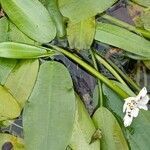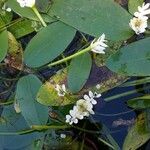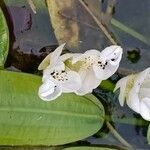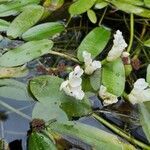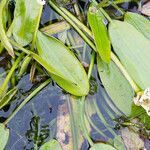Tubers up to 6 cm in diam., dark. Leaves with a floating lamina, lanceolate to oblong, 6-20 cm long and 2-7 cm broad, apex acute to obtuse, base rounded or shortly attenuate. Spikes bifid, many-flowered, up to 6 cm long. Flowers many, scented, dorsally arranged in 2 spreading rows, with the flowers on the one side slightly above those of the other; perianth-segments solitary, oblong to ovate-lanceolate, up to 18 mm long, delicate, white or occasionally pink, accrescent and green in fruit. Stamens 8-16, arranged in a circle, filaments thin, 3 mm long, anthers purple to black. Carpels 2-6 with c.4 ovules in each carpel. Follicles turbinate, c. 1 cm long with a straight beak, 1-4 seeded, seeds 9 mm long, with a spongy outer covering.
Leaves floating; petiole to 100 cm; blade ovate, narrowly oval, or narrowly lanceolate, 6--23 ´ 1.5--7.5 cm, base rounded to attenuate, apex obtuse to acute; veins 7--9. Inflorescences: spikes 1 or more, to 4.5 cm; spathe ca. 3 cm. Flowers in 2 rows, secund; tepals becoming green, enlarging, 10--15 ´ 3.5--6 mm, to 30 mm in fruit; veins 13 or more; stamens 3--4.5 mm; filaments expanded basally; anthers blackish purple; pollen yellow; pistils 2.5--3 ´ 0.7--1 mm; ovules usually 4. Fruits to 22 ´ 6 mm; beak 5 mm.
Perennial rhizomatous aquatic. Rhizomes up to 60 mm in diam. Leaves submerged and floating, floating leaves with petioles up to 1 m long; blades lanceolate to oblong, and apex pointed to rounded. Inflorescence of 2 spikes. Flowers arranged loosely in 2 rows on 1 side of each spike; perianth segment lanceolate to oblong, white to pinkish, petal-like, tinged with pink at base, highly scented. Flowering time peaks in Sept. Seeds with single coat, plumule small and partly covered by cotyledon.
A herb which grows in water and keeps growing from year to year. It has starchy storage roots or corms. It grows 60-80 cm high and spreads 80-100 cm wide. The leaves at the base arise from these tubers. The leaf stalks can be 1 m long. The leaves are narrowly oval and floating. They are 15 cm long by 5 cm wide. The flowering stalk grows above the water. It is divided and white. Each fork is 10 cm long with 6-12 oval and white bract like bodies with small flowers near their base.
Rhizomatous aquatic. Leaves with long slender petioles, floating blades oblong, 60-230 mm long. Inflorescence of 2 spikes on a scape up to 800 mm long. Flowers arranged in 2 rows on one side of each spike, white, with 1 large tepal, scented and edible.
Rhizomatous aquatic. Leaves floating, oblong. Flowers distichous, white, with 1 tepal, scented, stamens 8-16.
